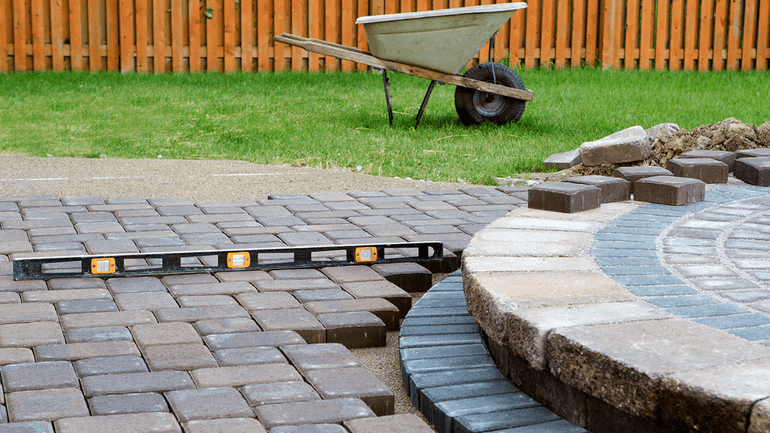The Best Patio Drainage Options & Solutions

This post was originally published on 4/25/18, and was updated on 2/13/20.
Are you thinking about building a patio this year? Patios are a popular DIY project for homeowners because they are so versatile and allow a wide range of options. Whether you’re planning to put down an elaborate pattern of pavers, or a straightforward series of concrete tiles, there are few foundational components to consider.
You will want to begin with a good base for your patio: smooth, flat, and level. This will make sure the patio lies evenly and minimizes the chances of trip hazards. You will also need to incorporate some method of drainage, to make sure rainwater doesn’t accumulate on the patio or around your foundation. Water sitting against the house will eventually seep in, leading to damp crawl spaces, a leaky basement, and a damaged foundation.
At Acculevel, we’ve been repairing foundations and waterproofing basements and crawl spaces since 1996. We have seen firsthand the kind of damage that results from water collecting around your foundation, and we want to help you avoid those issues. We’re going to review the fundamentals of landscape water drainage and give you some additional ideas and resources.
How Do You Begin Building a Patio?
Start with good preparation and planning: determine the best location, choose your materials, and decide what type/method of drainage you’d like to use. (More on that below.)
Determine the build location and mark it with paint or stakes. When you dig up the area, make sure you allow enough depth for both the pavers and the foundation layers. If you have bare spots in the yard, you might consider transplanting some of the sod. Why spend money on grass seed, if you can relocate healthy grass and soil?
Now that the area is excavated, you need to tamp down the soil, then put down landscape fabric to keep out weeds. An even layer of gravel is next, then a layer of sand. You will need to tamp down each layer thoroughly as a poorly compacted base can allow water to pool under the patio, or even wash out the gravel and sand. If this happens, you’ll need to pull up the patio and begin again.
After you have a stable, gradually sloped patio base, you’re ready to install edging and begin laying your pavers. For illustrated step-by-step instructions, you can check out this tutorial from the DIY Network. If you’re interested in a sealed style of pavers, The Spruce provides a guide for that variation.
What Type of Drainage System Should You Use?
Slope- when installing the base layer, you can introduce a gradual slope (approximately ¼ inch per foot) into the patio. If this grading can guide the water ‘downhill’ away from your home, you may not need to do anything else.
Slope Drain/French Drain- if the water is going to drain towards your house, or pool in an undesirable section of the yard, you’ll need to add some drainage to the mix. You can find french drain pipe at local hardware stores, or make your own out of PVC pipe. This should be installed around the edges of the patio, then a drainage line can be run from there to a place of your choosing.
If you have concerns about the grading (slope) of your yard, or are not sure about the best location for a french drain, you should consult with a landscaper or garden designer.
What Happens if Water Doesn’t Drain Off Your Patio?
A drainage system for your patio will help preserve your patio AND protect your home. Water that collects and pools near the foundation will cause damage to its stability. Over time, this water exerts pressure on your foundation, pushing it inward and creating cracks. Those cracks let in water, further weaken your foundation, and can eventually cause its collapse. Water in a basement or crawlspace will also create additional problems: mold, poor air quality, and damage to the wood framing system (beams, joists, sills).
Standing water on your patio will create mildew and gradually break down the pavers. Water pooling in the yard will attract insects like mosquitoes. None of these are desirable results, and will undermine your original purpose of improving your yard.
If you notice any issues with your foundation, basement or crawl space, we have a free tool that you can use for guidance. Our symptom tracker was built for homeowners that know they may have a problem, but aren’t sure what the best solution is.
Do You Need Foundation Repairs or Waterproofing?
The first step is to look for an experienced foundation company and make an appointment. Before you sign a contract for any service, always verify the company is reputable, insured, and accredited by the Better Business Bureau.
If you live in Indiana or the surrounding states, contact Acculevel and request a free estimate. Established in 1996, we specialize in foundation repairs and waterproofing basements and crawl spaces. An experienced project manager will evaluate the areas of concern and recommend the best course of action for you, to keep your home strong and healthy for years to come.
